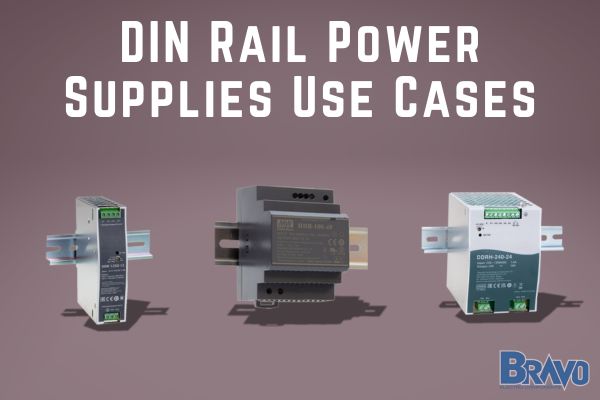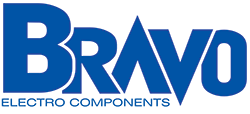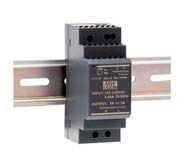
Of all the different types of power supply, the DIN rail style is one of the most popular for industrial use cases for its space-saving capabilities and ease of use. This translates into lower operating costs, making a quality DIN rail power supply from Bravo Electro a wise investment.
But what are DIN-rail power supplies used for, exactly? Can your operation really benefit from this style? We’re here to help you find out with a comprehensive look at all the common DIN rail uses below.
From industrial automation to factory automation, industrial control systems, semiconductor fabrication, renewable energy systems, telecommunications, IT systems, laboratory equipment, and more - the applications for these PSUs are seemingly endless.
You’ll also learn how to choose the optimal unit to power your project or products with precision. Get in touch with our world-class customer service team here at Bravo Electro for one-on-one help picking the perfect power supply to enjoy reliability and efficiency for years to come!
Overview of DIN Rail Power Supplies
First, let’s go over the basics of the DIN rail style PSU. These convert alternating current (AC) or direct current (DC) input into a stable output voltage to power up a wide range of devices or systems within industrial and automation environments. But that’s not what makes them unique.
These power supplies are designed to fit on the standard TS-35, TS-7.5 or TS-15 mounting rail (known as a DIN rail) which is commonly used in control panels, distribution boards, and industrial enclosures.
They’re a low profile power supply that works exceptionally well in installations where space is a precious commodity. They support effortless organization and easy integration with other system components like relays, circuit breakers, and terminal blocks.
They are also known for durability and flexibility thanks to features such as wide input AC and DC voltage ranges, protection mechanisms (overload, short circuit, overvoltage), and often fanless cooling to reduce maintenance requirements.
As you can imagine, these benefits are sought after across industries in a vast variety of applications. So, what are DIN-rail power supplies used for?
What Are DIN-Rail Power Supplies Used For?
Any use case that demands organization and integration with other systems along with a compact footprint can benefit from DIN-rail style power supplies. They’re one of the most common types of power supply connectors for a reason!
So, what are DIN-rail power supplies used for? Here are some of the applications that might align with your operation.
Industrial Automation
Programmable logic controllers (PLCs), sensors, and motors all need a steady and reliable power source. Precise voltage regulation is of the utmost importance, as downtime in production lines or manufacturing processes can be costly.
This is where DIN rail power supplies come in, offering the dependable functionality needed to keep business running smoothly and maximizing productivity. Features like surge protection further enhance stability.
Building Automation
Building automation systems range from lighting controls to HVAC systems to security systems. All of these share the common requirement of efficient, low-maintenance power solutions to handle varying electrical loads while keeping energy consumption low.
DIN rail power supplies provide steady performance across these devices and systems, operating within a wide range of temperatures and conditions to keep alarms, surveillance systems, and environmental controls dialed in without failure.
Factory Automation
Our world is placing an increased emphasis on streamlining production, getting more done in less time. DIN rail power supplies play an integral role as a reliable robotics power supply, maintaining the continuous operation of robotic systems, assembly lines, and conveyor belts.
They’re used to power sensors, actuators, and controllers that automate processes on the production floor. Their high power density and slim form factors align perfectly with the crowded control panels they get placed in, keeping machinery and equipment functioning as intended.
Industrial Control Systems
Industrial control systems, such as distributed control systems (DCS) and supervisory control and data acquisition (SCADA) systems, demand dependable power for safety, control, and monitoring in industrial environments.
DIN rail power supplies are the go-to choice for sectors such as oil and gas, chemical processing, and energy production. This is because their built-in protections against overvoltage and overcurrent enhance operational safety while preventing damage to sensitive control components.
Semiconductor Fabrication
Clean, stable power is a must for the semiconductor manufacturing industry. This is a high-stakes process where precision is of the utmost importance, which is why DIN rail PSUs are the gold standard.
They power equipment like wafer processing machines and lithography tools, where even minor voltage fluctuations could lead to costly defects. Their precise voltage output, low ripple, and noise-free operation support even the most stringent semiconductor manufacturing processes.
Telecommunications and IT Infrastructure
Uninterrupted power is essential for keeping servers, routers, and communication systems live - and in turn, keeping our world connected. So, what are DIN-rail power supplies used for in this application?
They provide power to network equipment in data centers, base stations, and communication hubs. The design aligns perfectly with the continuous power demands of IT infrastructure, while features like active PFC help reduce energy consumption and heat generation for a longer lifespan.
Renewable Energy Systems
DIN rail power supplies are becoming more and more common as the heartbeat behind solar panel installations and wind turbines as well. They convert the power generated by these renewable sources into a stable output. It can then be used to charge batteries or feed the grid.
Given how much these sources tend to fluctuate, the stability and versatility of DIN rail power supplies is a perfect pairing to protect against voltage surges while providing consistent power.
Transportation and Rail Systems
Even the transportation industry relies on DIN rail power supplies to keep signaling systems, ticketing machines, and communication networks running smoothly around the clock.
Part of the reason they’re chosen is their durable, rugged build quality. They can withstand the harsh conditions encountered in outdoor environments, including extreme temperatures and vibrations.
This translates into reliability, which is a non-negotiable in the transportation industry. The last thing operators need is system failures contributing to delays or cancellations.
Laboratory Equipment
Last but not least on our list of DIN rail uses, these power supplies support laboratory environments by powering the equipment used in testing, measurement, and research applications.
That includes the basics like microscopes to more advanced analyzers and diagnostic tools. Across these use cases, their ability to consistently deliver stable power output in even the most sensitive applications is what sets them apart.
After all, the accuracy and reliability of lab equipment cannot be taken lightly. Plus, labs can be tight on space, and their smaller form factor makes DIN rail PSUs a perfect option.
Tips on Choosing the Right DIN-Rail Power Supply
If your application needs unparalleled reliability in a compact design, chances are, you can rely on DIN rail power supplies. But, not all units are created equal, from variances in power supply voltage to power supply specs, safeties, and more.
So, what power supply do I need? We’ll help you pick the optimal DIN rail power supply below, but remember - personalized assistance is just a click or call away at Bravo Electro.
Assessing Power Requirements
First, you need to determine the output voltage and power output necessary to support your equipment. Most industrial applications will fall into one of three voltages:
However, that’s not always the case, as you may need a 5v or higher voltage power supply. Always do your due diligence to confirm power requirements before you start shopping.
This is as simple as calculating the total wattage your devices will draw. Keep in mind that it’s often recommended to choose a power supply with a capacity that exceeds your total power requirement by 25-30% for reliable performance even under peak loads.
For systems with power demands that frequently fluctuate, make sure you’re getting a power supply with a wide output range and peak load capabilities to manage power surges without causing failure.
But, you need to make sure you’re taking note of the input voltage as well. DIN rail PSUs will fall into one of three ranges:
- Single-phase inputs are common in residential or small commercial setups, typically ranging from 85V to 264VAC.
- Two-phase or split-phase systems provide higher power delivery with two alternating current waveforms.
- Three-phase inputs are commonplace in industrial environments with high power requirements. These systems are more efficient and reduce the stress on individual wires, distributing the load evenly across three wires.
Making sure to account for each of these factors will deliver optimal performance and reduced energy loss for the most efficient power supply operation.
Environmental and Protection Factors
The setting in which you’re installing a power supply must be carefully considered as well. Temperature, humidity, and exposure to dust or moisture can all take a toll on the performance and longevity of your power supply.
So, take note of the operating temperature range of a power supply before you buy. Many are equipped to handle wide ranges from -30°C to +70°C. Other important protection features are:
- Overvoltage Protection to prevent voltage spikes from damaging sensitive equipment.
- Overload Protection to automatically shut down the power supply in case of excessive power demand.
- Short Circuit Protection to safeguard the system from potential electrical shorts that could cause overheating or equipment failure.
- Thermal Protection to prevent overheating by reducing the power output or shutting down the system if temperatures exceed safe levels.
You also need to choose the optimal IP (Ingress Protection) rating for your equipment, as this will keep sensitive electrical components safe from dust, water, or other particulates that could compromise the unit.
Efficiency and Power Factor Correction (PFC)
Choosing a highly efficient DIN-rail power supply reduces energy consumption, minimizes heat generation, and lowers overall operational costs. Many models are rated as high as 90% so that as little power is lost during the conversion process as possible.
Power Factor Correction (PFC) is a feature that reduces the difference between the power supplied and the power consumed by the load. It’s especially important for keeping industrial applications compliant with international energy standards while reducing energy wastage.
Power supplies with active PFC are also more resilient against harmonic distortion, so you can enjoy smooth and stable power delivery across your system.
Size and Form Factor
We’ve mentioned throughout this guide that DIN rail power supplies are inherently low-profile and compact, but the specific size and form factor will vary from model to model.
You need to ensure the unit you choose will fit seamlessly into your control panel or enclosure without overcrowding other components. Widths can be as narrow as 32mm in some cases.
Figure out whether you need a metal case for added durability or a plastic case for lighter-weight applications. This will depend on whether you’re more interested in protection against the elements or compactness.
Compliance and Certifications
Perhaps most importantly, make sure you are choosing a power supply that aligns with the specific compliance requirements for your use case. Here are some common examples:
- UL/cUL and CE certifications for general safety and electromagnetic compatibility.
- IEC 62368-1 for information technology equipment and industrial use.
- IEC 60601-1 certification for compliance with stringent medical safety standards.
- TUV and CB certifications to confirm that the power supply meets global safety standards.
You can learn more about the various power supply certifications in our blog. Otherwise, it’s time to find the perfect AC DC power supply or DC to DC power supply at Bravo Electro!
Enjoy High Reliability and Performance at Bravo Electro!
Bravo Electro is your one-stop shop for all your power supply and fan needs. When you shop with us you’ll gain access to the top products from the most trusted power supply manufacturers at unbeatable prices with exceptional customer service along the way.
That includes the highly popular range of MEAN WELL DIN rail power supplies, which represent the pinnacle of power supply. They’re available in voltages such as:
Because of our tight relationship with MEAN WELL, we’re able to keep our pricing low and even offer a custom power supply if one of these standard solutions doesn't meet your needs.
It’s as simple as filling out our custom power requirements form. From there, our expert electrical engineers will be in touch to create something tailored to your specific application.
We also have modular power supplies, external power supplies, LED driver power supplies, and so much more. So, browse our catalog as we wrap up our DIN rail uses guide or get in touch for one-on-one assistance today!
Final Thoughts on the DIN-Rail Power Supply Use Cases
So, what are DIN-rail power supplies used for? As you can see, there are a seemingly endless number of applications for these versatile, compact, highly reliable PSUs - from industrial automation to telecommunications and renewable energy.
We hope this guide has left you with a clear understanding of all the different use cases along with how to choose the optimal power source for your specific needs.
Our blog has more resources on how to hook up a DIN rail power supply, or how to wire MEAN WELL DIN rail power supplies specifically.
You can laso learn about the signs of faulty power supply, power supply making buzzing noise, how to check PSU wattage, linear vs switching power supply, how to fix power supply, LED driver failure symptoms, troubleshooting power supply, and more.
Otherwise, it’s time to see for yourself what makes Bravo Electro the #1 source for all your electrical component needs. Confidently power any operation with our unbeatable selection of DIN-rail power supplies to meet any requirements!










